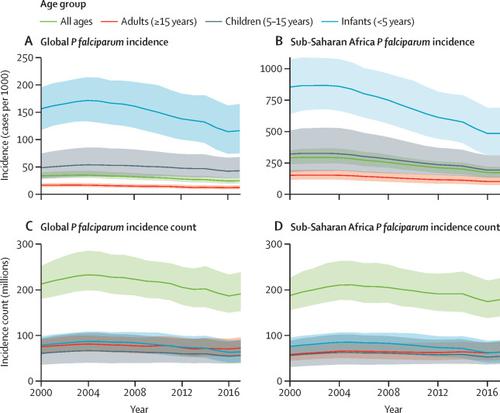Our official English website, www.x-mol.net, welcomes your feedback! (Note: you will need to create a separate account there.)
Mapping the global prevalence, incidence, and mortality of Plasmodium falciparum, 2000-17: a spatial and temporal modelling study.
The Lancet ( IF 168.9 ) Pub Date : 2019-06-19 , DOI: 10.1016/s0140-6736(19)31097-9 Daniel J Weiss 1 , Tim C D Lucas 1 , Michele Nguyen 1 , Anita K Nandi 1 , Donal Bisanzio 2 , Katherine E Battle 1 , Ewan Cameron 1 , Katherine A Twohig 1 , Daniel A Pfeffer 3 , Jennifer A Rozier 1 , Harry S Gibson 1 , Puja C Rao 4 , Daniel Casey 5 , Amelia Bertozzi-Villa 6 , Emma L Collins 1 , Ursula Dalrymple 7 , Naomi Gray 8 , Joseph R Harris 1 , Rosalind E Howes 1 , Sun Yun Kang 1 , Suzanne H Keddie 1 , Daniel May 1 , Susan Rumisha 1 , Michael P Thorn 1 , Ryan Barber 4 , Nancy Fullman 4 , Chantal K Huynh 4 , Xie Kulikoff 4 , Michael J Kutz 4 , Alan D Lopez 4 , Ali H Mokdad 4 , Mohsen Naghavi 4 , Grant Nguyen 4 , Katya Anne Shackelford 4 , Theo Vos 4 , Haidong Wang 4 , David L Smith 4 , Stephen S Lim 4 , Christopher J L Murray 4 , Samir Bhatt 9 , Simon I Hay 4 , Peter W Gething 1
The Lancet ( IF 168.9 ) Pub Date : 2019-06-19 , DOI: 10.1016/s0140-6736(19)31097-9 Daniel J Weiss 1 , Tim C D Lucas 1 , Michele Nguyen 1 , Anita K Nandi 1 , Donal Bisanzio 2 , Katherine E Battle 1 , Ewan Cameron 1 , Katherine A Twohig 1 , Daniel A Pfeffer 3 , Jennifer A Rozier 1 , Harry S Gibson 1 , Puja C Rao 4 , Daniel Casey 5 , Amelia Bertozzi-Villa 6 , Emma L Collins 1 , Ursula Dalrymple 7 , Naomi Gray 8 , Joseph R Harris 1 , Rosalind E Howes 1 , Sun Yun Kang 1 , Suzanne H Keddie 1 , Daniel May 1 , Susan Rumisha 1 , Michael P Thorn 1 , Ryan Barber 4 , Nancy Fullman 4 , Chantal K Huynh 4 , Xie Kulikoff 4 , Michael J Kutz 4 , Alan D Lopez 4 , Ali H Mokdad 4 , Mohsen Naghavi 4 , Grant Nguyen 4 , Katya Anne Shackelford 4 , Theo Vos 4 , Haidong Wang 4 , David L Smith 4 , Stephen S Lim 4 , Christopher J L Murray 4 , Samir Bhatt 9 , Simon I Hay 4 , Peter W Gething 1
Affiliation

|
BACKGROUND
Since 2000, the scale-up of malaria control interventions has substantially reduced morbidity and mortality caused by the disease globally, fuelling bold aims for disease elimination. In tandem with increased availability of geospatially resolved data, malaria control programmes increasingly use high-resolution maps to characterise spatially heterogeneous patterns of disease risk and thus efficiently target areas of high burden.
METHODS
We updated and refined the Plasmodium falciparum parasite rate and clinical incidence models for sub-Saharan Africa, which rely on cross-sectional survey data for parasite rate and intervention coverage. For malaria endemic countries outside of sub-Saharan Africa, we produced estimates of parasite rate and incidence by applying an ecological downscaling approach to malaria incidence data acquired via routine surveillance. Mortality estimates were derived by linking incidence to systematically derived vital registration and verbal autopsy data. Informed by high-resolution covariate surfaces, we estimated P falciparum parasite rate, clinical incidence, and mortality at national, subnational, and 5 × 5 km pixel scales with corresponding uncertainty metrics.
FINDINGS
We present the first global, high-resolution map of P falciparum malaria mortality and the first global prevalence and incidence maps since 2010. These results are combined with those for Plasmodium vivax (published separately) to form the malaria estimates for the Global Burden of Disease 2017 study. The P falciparum estimates span the period 2000-17, and illustrate the rapid decline in burden between 2005 and 2017, with incidence declining by 27·9% and mortality declining by 42·5%. Despite a growing population in endemic regions, P falciparum cases declined between 2005 and 2017, from 232·3 million (95% uncertainty interval 198·8-277·7) to 193·9 million (156·6-240·2) and deaths declined from 925 800 (596 900-1 341 100) to 618 700 (368 600-952 200). Despite the declines in burden, 90·1% of people within sub-Saharan Africa continue to reside in endemic areas, and this region accounted for 79·4% of cases and 87·6% of deaths in 2017.
INTERPRETATION
High-resolution maps of P falciparum provide a contemporary resource for informing global policy and malaria control planning, programme implementation, and monitoring initiatives. Amid progress in reducing global malaria burden, areas where incidence trends have plateaued or increased in the past 5 years underscore the fragility of hard-won gains against malaria. Efforts towards elimination should be strengthened in such areas, and those where burden remained high throughout the study period.
FUNDING
Bill & Melinda Gates Foundation.
中文翻译:

绘制2000-17年恶性疟原虫的全球患病率,发病率和死亡率的图:一项时空建模研究。
背景技术自2000年以来,疟疾控制干预措施的大规模推广已大大降低了全球由该疾病引起的发病率和死亡率,为消除疾病的大胆目标提供了动力。随着地理空间解析数据可用性的提高,疟疾控制计划越来越多地使用高分辨率地图来表征疾病风险的空间异质性模式,从而有效地针对高负担地区。方法我们更新和完善了撒哈拉以南非洲地区恶性疟原虫的寄生虫发生率和临床发病率模型,该模型依靠横断面调查数据获得寄生虫发生率和干预覆盖率。对于撒哈拉以南非洲以外的疟疾流行国家,我们通过对通过常规监测获得的疟疾发病率数据采用生态缩减方法,得出了寄生虫发生率和发病率的估计值。死亡率估算是通过将发病率与系统得出的生命登记和口头尸检数据联系起来而得出的。借助高分辨率的协变量表面,我们估计了恶性疟原虫的寄生虫发生率,临床发生率以及在国家,国家以下和5×5 km像素尺度下的死亡率,并带有相应的不确定性度量。结果我们展示了自2010年以来的第一张全球高分辨率恶性疟原虫死亡率图和第一张全球流行率和发病率图。这些结果与间日疟原虫的结果(单独出版)相结合,形成了全球疟疾全球负担的疟疾估算值疾病2017研究。恶性疟原虫的估计时间跨度为2000-17年,说明2005年至2017年间负担迅速减少,发病率下降了27·9%,死亡率下降了42·5%。尽管流行地区人口不断增加,但恶性疟原虫病例在2005年至2017年期间有所下降,从232·300万(95%不确定区间198·8-277·7)降至193·900万(156·6-240·2)和死亡人数从925800(596 900-1 341 100)降至618 700(368 600-952 200)。尽管负担有所减轻,但撒哈拉以南非洲地区仍有90·1%的人居住在流行地区,2017年该地区的病例数为79·4%,死亡人数为87·6%。恶性疟原虫提供了当代资源,可为全球政策和疟疾控制规划,计划实施和监测计划提供信息。在减轻全球疟疾负担方面取得进展的同时,过去五年来发病率趋势趋于平稳或增加的地区凸显了来之不易的抗击疟疾成果的脆弱性。在这些领域以及在整个研究期间负担仍然很高的领域,应加强消除消灭的努力。资金比尔和梅琳达·盖茨基金会。
更新日期:2019-07-26
中文翻译:

绘制2000-17年恶性疟原虫的全球患病率,发病率和死亡率的图:一项时空建模研究。
背景技术自2000年以来,疟疾控制干预措施的大规模推广已大大降低了全球由该疾病引起的发病率和死亡率,为消除疾病的大胆目标提供了动力。随着地理空间解析数据可用性的提高,疟疾控制计划越来越多地使用高分辨率地图来表征疾病风险的空间异质性模式,从而有效地针对高负担地区。方法我们更新和完善了撒哈拉以南非洲地区恶性疟原虫的寄生虫发生率和临床发病率模型,该模型依靠横断面调查数据获得寄生虫发生率和干预覆盖率。对于撒哈拉以南非洲以外的疟疾流行国家,我们通过对通过常规监测获得的疟疾发病率数据采用生态缩减方法,得出了寄生虫发生率和发病率的估计值。死亡率估算是通过将发病率与系统得出的生命登记和口头尸检数据联系起来而得出的。借助高分辨率的协变量表面,我们估计了恶性疟原虫的寄生虫发生率,临床发生率以及在国家,国家以下和5×5 km像素尺度下的死亡率,并带有相应的不确定性度量。结果我们展示了自2010年以来的第一张全球高分辨率恶性疟原虫死亡率图和第一张全球流行率和发病率图。这些结果与间日疟原虫的结果(单独出版)相结合,形成了全球疟疾全球负担的疟疾估算值疾病2017研究。恶性疟原虫的估计时间跨度为2000-17年,说明2005年至2017年间负担迅速减少,发病率下降了27·9%,死亡率下降了42·5%。尽管流行地区人口不断增加,但恶性疟原虫病例在2005年至2017年期间有所下降,从232·300万(95%不确定区间198·8-277·7)降至193·900万(156·6-240·2)和死亡人数从925800(596 900-1 341 100)降至618 700(368 600-952 200)。尽管负担有所减轻,但撒哈拉以南非洲地区仍有90·1%的人居住在流行地区,2017年该地区的病例数为79·4%,死亡人数为87·6%。恶性疟原虫提供了当代资源,可为全球政策和疟疾控制规划,计划实施和监测计划提供信息。在减轻全球疟疾负担方面取得进展的同时,过去五年来发病率趋势趋于平稳或增加的地区凸显了来之不易的抗击疟疾成果的脆弱性。在这些领域以及在整个研究期间负担仍然很高的领域,应加强消除消灭的努力。资金比尔和梅琳达·盖茨基金会。


























 京公网安备 11010802027423号
京公网安备 11010802027423号